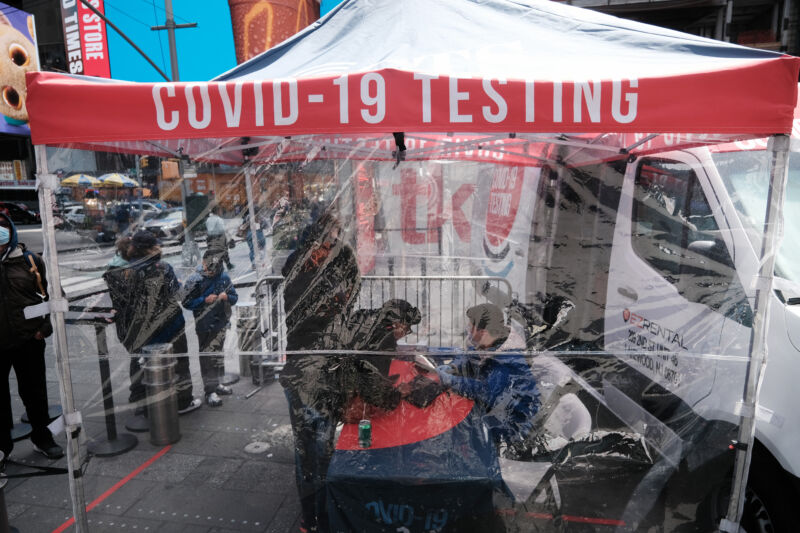Omicron coronavirus subvariants BA.4 and BA.5 are now accounting for an estimated 35 percent of US cases, according to the Centers for Disease Control and Prevention. The subvariants are on a course to reach dominance at a faster clip than the subvariants before them, including the current reigning subvariant, BA.2.12.1, which is now in decline.
The pair—which share the same mutations in their SARS-CoV-2 spike proteins but have differences elsewhere in their genomes—are expected to reach dominance "in a few weeks," Dr. Shishi Luo tells Ars. Luo is the head of infectious diseases at Helix, a California-based population genomics and viral surveillance company that works with the CDC to help track emerging coronavirus variants nationwide.
It's unclear exactly what's ahead in this latest phase of the pandemic. What we know of the two subvariants so far is mixed.
Bad and good news
When BA.4 and BA.5 were first detected in South Africa in April, it quickly became clear that the two can evade immune responses from vaccination and past infection, even infection from previous omicron variants.
On Wednesday, researchers in Boston published data in the New England Journal of Medicine that reinforced those findings. The latest data found that people who had been vaccinated and boosted had 21-fold lower neutralizing antibody titers against BA.4 and BA.5 compared to levels against the original version of SARS-CoV-2. And those neutralizing antibody levels were also 3.3-fold lower compared to levels against BA.1. Likewise, in people who had previously been infected with BA.1 or BA.2 (most of whom had been vaccinated, too), neutralizing antibody levels against BA.4 and BA.5 were still nearly 3-fold lower than levels against BA.1.
Moreover, a preprint study posted recently found that BA.4 and BA.5 appeared to cause more severe disease in hamsters than BA.2 and BA.2.12.1.
But, there is some good news so far: Hospitalization data from other countries where BA.4 and BA.5 have already surged—including South Africa—suggests that the variants are not causing more severe disease and hospitalizations in humans.
So, with antivirals that are still effective and vaccination still protecting from severe disease and death, Luo says it's not time to be really worried. "I don't think that's necessary," Luo said of the coming wave.
What's ahead
But, as BA.4 and BA.5 approach dominance in the US—making them the fourth and fifth omicron subvariants to dominate cases this year alone after BA.1, BA.2, and BA.2.12.1—the question looms: What's next?
With BA.4 and BA.5 arising in South Africa weeks ago, we had the opportunity to see this next wave coming. But, "right now there doesn't seem to be any other variants that are rising," Luo said. There are always some virus samples here and there that don't have an assigned lineage yet—that may be new variants—but none appear to be picking up speed, infecting a growing number of people, she said. That means BA.4 and BA.5 could enjoy a longer reign than their predecessors in the absence of any up-and-coming usurpers.
"But you know, that could change in the next few days," Luo said. "I wouldn't put it past this virus to mutate yet again and for there to be yet another wave."
Federal regulators and vaccine makers are preparing for omicron subvariants to be with us at least into the fall and winter. The Food and Drug Administration is gearing to authorize next-generation vaccines and boosters for the fall that could thwart a seasonal surge. Expert advisors for the regulator will meet next week, June 28, to discuss the formulation of those next-generation vaccines. The top candidates are those that target omicron.
Short- and long-term plans
On Wednesday, Moderna released preliminary top-line data that it will present to the FDA, showing that its combination (bivalent) vaccine targeting both the original version of SARS-CoV-2 and the original omicron variant can boost protection against BA.4 and BA.5. Moderna says the bivalent booster, dubbed mRNA-1273.214, can increase neutralizing antibody levels against BA.4 and BA.5 up to 6-fold.
"In the face of SARS-CoV-2's continued evolution, we are very encouraged that mRNA-1273.214, our lead booster candidate for the fall, has shown high neutralizing titers against the BA.4 and BA.5 subvariants, which represent an emergent threat to global public health," Moderna CEO Stéphane Bancel said in a statement. "We will submit these data to regulators urgently and are preparing to supply our next-generation bivalent booster starting in August, ahead of a potential rise in SARS-CoV-2 infections due to omicron subvariants in the early fall."
While Moderna's short-term outlook is optimistic, Luo worries about the continued viral evolution and our diminishing potential to detect new variants. As people try to move on from the acute phase of the pandemic, people are submitting fewer samples for testing. "Looking ahead, we have to figure out, will there be [enough samples]? ... If not, then will there be enough people presenting at urgent care, or health systems, or hospitals, where there is an opportunity to take a sample and send it for sequencing? I think a system that does that at scale doesn't exist yet," Luo said.
Though Helix is looking into ways to set up such surveillance systems, Luo says there needs to be a broader national strategy for staying ahead of variants. Even if, right now, we don't think there's another variant on the horizon, it does appear we need a plan for how we're going to, as a country, deal with responding to it," she said. "We can't just keep hoping it goes away by itself." In a worst-scenario that another variant arises that thwarts treatments and vaccines, "we don't want to go back to square one, right? We need a plan."



3175x175(CURRENT).thumb.jpg.b05acc060982b36f5891ba728e6d953c.jpg)

Recommended Comments
There are no comments to display.
Join the conversation
You can post now and register later. If you have an account, sign in now to post with your account.
Note: Your post will require moderator approval before it will be visible.